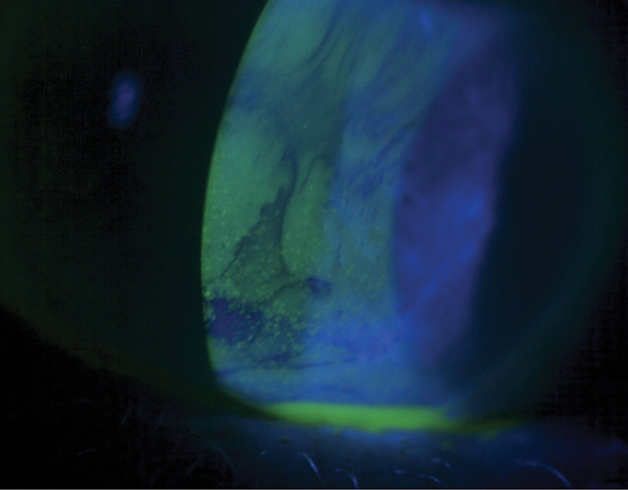 |
|
Due to its wide-range of presentations, dry eye diagnosis and management is inherently complex, leading to a lack of consistency between clinical signs and symptoms. A study investigated the new Dry Eye Severity Index (DESI) and its relevance as a biomarker. Researchers found DESI did in fact correlate significantly with symptoms, and was shown to be predictive and reliable in identifying the disease’s pathology. Photo: Jack Schaeffer, OD. Click image to enlarge. |
A major challenge to the proper diagnosis of dry eye is the inconsistency between the signs and symptoms. Because the disease itself is multifactorial, some patients can experience a range of complaints while others may have no symptoms at all. In addition, the absence of a gold standard measure for identifying dry eye disease (DED) underscores the need for novel diagnostic approaches that integrate objective markers with the patients’ subjective experience. That was the goal set out by researchers from Spain whose recent study, published in Ophthalmic and Physiological Optics, tested a new biomarker called the Dry Eye Severity Index, and in turn discovered a significant correlation with the signs and symptoms of dry eye.
A total of 71 DED subjects (63% female), with a median age of 64, were included in the cross-sectional, observational study. Researchers recorded a battery of subjective and objective measures, including:
• subjective symptom descriptions
• Quality of Vision (QoV) and Ocular Surface Disease Index (OSDI) questionnaires to quantify visual quality and dry eye signs, respectively
• best-corrected distance visual acuity as well as functional visual acuity, the latter being the acuity achieved after 10 seconds without blinking or after the patient blinked involuntarily
• contrast sensitivity
• higher- and lower-order corneal aberrations
• meibography imaging and assessment of meibomian gland dysfunction (MGD) status
• Schirmer test score and tear break-up time (TBUT)
• corneal staining and lid wiper epitheliopathy scores
Participants were classified into three groups based on dryness severity using a cluster analysis (i.e., grouping them by the tightness of their association) to arrive at mild (n=17, 55.8 years), moderate (n=41, 63.5 years) and severe (n=13, 65.0) groups. The three key measures used in this stratification were TBUT, Schirmer’s score and MGD status. Those same three factors were used as the building blocks for a new metric the authors call the Dry Eye Severity Index (DESI). “These parameters were selected because they allowed good classification or grading of the DED patients included in the study,” the researchers noted in their paper. DESI is intended to combine signs, symptoms and visual quality into one score.
DESI showed significant differences between different pairs of groups (mild, moderate and severe), and was highly correlated with age. In terms of gender distribution, the mild group had a higher percentage of male subjects (59%), whereas the moderate and severe groups had more women (76% and 54%, respectively). Visual function and optical quality parameters showed significant differences between the dryness severity groups. Acuity was significantly better in the mild group than the others.
Researchers concluded that the higher the DESI, the worse the acuity results. “Likewise, those patients with higher DESI also showed poorer contrast sensitivity, suggesting that this index is a good indicator of visual quality,” the authors wrote. Higher DESI score also correlated with worse subjective dry eye symptoms score on OSDI and the visual quality symptoms score using QoV.
The authors believe DESI may become a valuable tool moving forward, as (in their estimation) it was shown to be predictive and reliable in identifying disease severity as well as visual quality. however, the researchers did not offer a clinical method for adoption of DESI in practice, as more work needs to be done and, in this case especially, further studies are warranted.
“The absence of a control group precludes a comparison with healthy individuals, which would enhance the validation of the DESI index,” they wrote. Also, as “results were based on a limited sample, with groups comprising different numbers of participants and gender distributions,” future studies should include larger and more representative samples. They also mentioned that additional research should investigate how DESI score changes once a patient has undergone dry eye treatments such as meibomian gland expression or intense pulsed light.
To counter the complexities of diagnosing and managing dry eye, researchers concluded that novel tools such as DESI are necessary. “This study described the new DESI which showed a significant correlation with signs and symptoms of DE. It will be useful to determine the severity and to compare signs, symptoms and visual quality amongst individuals with varying levels of DE,” they concluded.
Gala-Núñez C, Ortiz-Peregrina S, Castanera-Gratacós D, Anera RG. Development of a dry eye index as a new biomarker of dry eye disease. Ophthalmic Physiol Opt. August 2, 2024. [Epub ahead of print]. |


